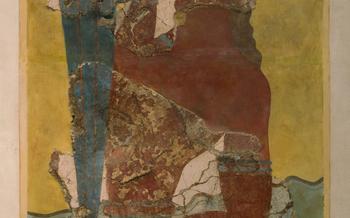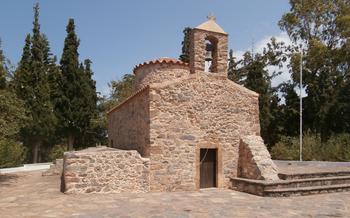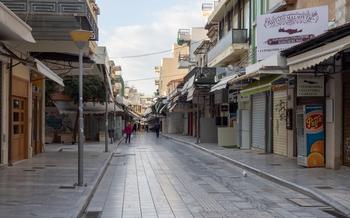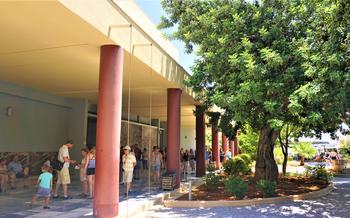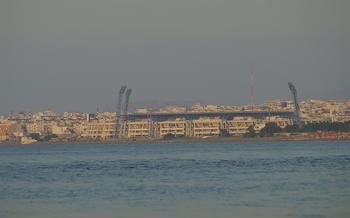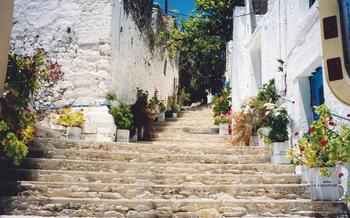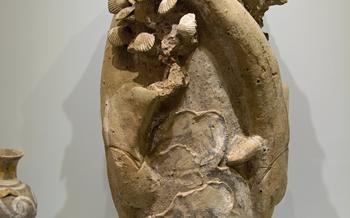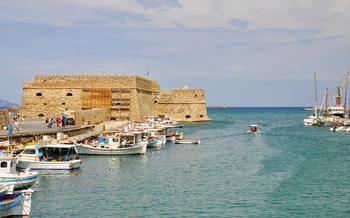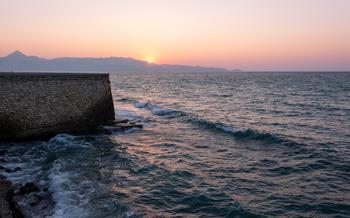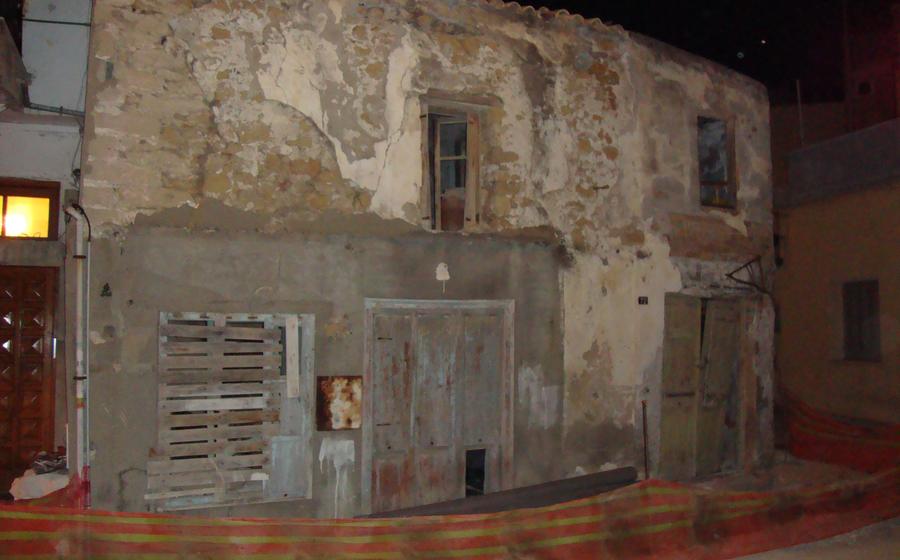
Gournia Archaeological Site
- Historical Significance
- Unique Features
- Exploring the Site
- Museum of Gournia
- Prehistoric Houses
- Storage Areas
- Artisanal Workshops
- Religious Structures
- Burials
- Stunning Views
- Combination Tours
- Best Time to Visit
- Local Cuisine
- Accommodation Options
- Insider Tip: Unveiling Gournia's Hidden Treasures
Historical Significance
The ancient site of Gournia, nestled on the eastern coast of Crete, holds immense historical significance as a testament to the origins and development of the Minoan civilization. This Bronze Age culture, flourishing between 2700 and 1450 BC, played a pivotal role in shaping the foundation of European civilization.
Archaeological excavations at Gournia, meticulously conducted over several decades, have unearthed a wealth of artifacts, structures, and insights into the daily lives of the Minoans. These discoveries have shed light on their urban planning, social organization, and intricate water management systems, providing a glimpse into the sophisticated society that thrived here.
Gournia's strategic location on the Mirabello Bay facilitated trade and cultural exchange with neighboring regions, contributing to the Minoan civilization's rise as a maritime power. The site's well-preserved remains, including round buildings, narrow streets, and a central square, offer a tangible connection to this ancient civilization, allowing visitors to step back in time and experience the grandeur of Minoan Crete.
Unique Features
Gournia stands out among other Minoan sites due to its unique architectural features. The city showcases a remarkable collection of round buildings, believed to serve as homes for its inhabitants. These structures, constructed with stone and mud bricks, exhibit a distinctive circular design, a rarity in Minoan architecture. Their rounded form is thought to have provided structural stability and facilitated air circulation within the dwellings.
In addition to its round buildings, Gournia boasts an intricate drainage system, a testament to the advanced urban planning of the Minoan civilization. This network of channels and underground tunnels effectively managed rainwater and wastewater, preventing flooding and ensuring the site's sanitation. The Minoans also demonstrated their engineering prowess in the construction of fortifications, narrow streets, and a central square, creating a well-organized and functional urban environment.
Exploring the Site
Gournia's location on a low hilltop offers stunning panoramic views of the surrounding landscape, with the Mirabello Gulf and the Lasithi Plateau stretching out in the distance. The archaeological site is easily accessible by car or public transportation, and there is a small parking lot available near the entrance.
Once inside the site, visitors can embark on a journey through time as they explore the well-preserved remains of this ancient city. Walking trails and paths wind their way through the ruins, leading visitors past the round buildings, storage areas, and artisanal workshops. Detailed maps and guidebooks are available for self-guided tours, providing insights into the history and significance of each structure.
The central square of Gournia is a particularly impressive sight, with its well-preserved stone-paved streets and surrounding buildings. Here, visitors can imagine the hustle and bustle of daily life in this ancient city, as people went about their daily routines, trading goods, and socializing.
Museum of Gournia
A visit to the Gournia Archaeological Site would not be complete without exploring its dedicated museum. This treasure trove houses an impressive collection of artifacts and findings unearthed during the excavations. Stroll through the exhibits and discover a fascinating array of pottery, tools, jewelry, and other relics that provide glimpses into the daily lives and practices of the Minoans.
Interactive displays and educational exhibits bring the past to life, offering insights into the social structure, economy, and religious beliefs of this ancient civilization. Learn about their intricate drainage system, agricultural practices, and the skills of their artisans. The museum serves as a gateway to understanding the rich history and cultural significance of Gournia, making it an essential stop on any exploration of the site.
Prehistoric Houses
The well-preserved houses at Gournia offer a fascinating glimpse into the domestic architecture and construction techniques of the Minoans. These houses were typically built using stone foundations and mudbrick walls, with roofs made of wood and thatch. The rooms were small and often interconnected, with windows and doorways that were narrow to keep out the heat and cold. The houses were also equipped with hearths for cooking and heating, as well as storage areas for food and other belongings.
One of the most interesting features of the Gournia houses is their round shape. This unique design is thought to have been inspired by the natural caves that the Minoans used as shelter before they began building permanent structures. The round shape also provided better ventilation and helped to keep the houses cool in the summer.
Exploring the houses at Gournia is like stepping back in time. Visitors can see where the Minoans slept, cooked, and worked, and get a sense of their daily lives. The houses are a testament to the ingenuity and craftsmanship of the Minoan people, and they provide valuable insights into the development of early urban societies in Greece.
Storage Areas
At Gournia, extensive storage facilities provide a glimpse into the economic and agricultural practices of the Minoans. Large storage rooms and pithoi, enormous terracotta jars, were utilized to store surplus agricultural products. These storage facilities indicate a well-organized system of food production and trade. The presence of large storage facilities also suggests that the Minoans had a sophisticated understanding of agriculture and were able to produce enough surplus to support a growing population and engage in trade with other communities.
Artisanal Workshops
Gournia offers a remarkable glimpse into the artisanal skills and industries of the Minoans through its numerous workshops. These specialized areas, often concentrated in specific neighborhoods, showcase the craftsmanship and technical prowess of the ancient residents.
Within these workshops, archaeologists have unearthed a wealth of tools and equipment used by skilled artisans to create a variety of goods. From pottery kilns and molds to metalworking tools and anvils, these artifacts provide tangible evidence of the vibrant craft traditions that flourished at Gournia.
Pottery was a particularly important industry, with numerous workshops dedicated to the production of ceramic vessels. Artisans used local clay to create a wide range of pottery, including utilitarian items such as cooking pots and storage jars, as well as more elaborate vessels with intricate designs and decorative motifs.
Metalworking was another significant craft, with workshops specializing in the production of bronze tools, weapons, and ornaments. The discovery of metal ingots and casting molds suggests that metalworking was carried out on a substantial scale at Gournia, catering to the needs of the local population and possibly even engaging in trade with other settlements.
These artisanal workshops not only provided essential goods for daily life but also contributed to the economic prosperity and cultural vitality of Gournia. The skills and techniques developed by these ancient artisans continue to inspire contemporary craftspeople and provide valuable insights into the ingenuity and creativity of the Minoan civilization.
Religious Structures
While exploring the ancient city of Gournia, visitors will encounter several religious structures that offer a glimpse into the spiritual beliefs and practices of the Minoan civilization. Shrines, altars, and various religious artifacts have been discovered at the site, providing valuable insights into the religious life of this prehistoric society.
The most prominent religious structure at Gournia is a large shrine located in the central part of the city. This shrine features a raised platform, possibly used for religious rituals or offerings, surrounded by benches where worshippers may have gathered. Several smaller shrines have also been found throughout the site, indicating the widespread practice of religious rituals within the community.
Altars, often associated with sacrifices and offerings, are another common feature of the religious structures at Gournia. These altars, made of stone or clay, were used for various religious ceremonies and rituals. The discovery of these altars suggests that the Minoans engaged in animal sacrifices and other forms of offerings to their deities.
In addition to shrines and altars, archaeologists have uncovered a variety of religious artifacts at Gournia, including figurines, pottery vessels, and jewelry with religious symbols. These artifacts provide further evidence of the Minoans' religious beliefs and practices, shedding light on their pantheon of gods and goddesses, as well as their conceptions of the afterlife.
Exploring the religious structures and artifacts at Gournia offers a unique opportunity to delve into the spiritual world of the Minoan civilization. These remains provide valuable insights into the beliefs, rituals, and practices that shaped the religious life of this ancient society.
Burials
At Gournia, archaeologists have unearthed a treasure trove of information about Minoan burial practices. Several graves have been discovered within the site, providing valuable insights into the rituals, beliefs, and customs surrounding death and the afterlife. These graves vary in size and complexity, ranging from simple pits to elaborate chamber tombs. Some graves contain the remains of a single individual, while others hold multiple burials.
The study of these graves has revealed that the Minoans buried their dead with a variety of grave goods, including pottery vessels, tools, weapons, and jewelry. These items were likely intended to accompany the deceased into the afterlife, providing them with the necessities for their journey. In some cases, the graves also contained evidence of food offerings, suggesting that the Minoans believed in providing sustenance for the deceased in the afterlife.
Through the examination of these burial practices, archaeologists have gained a deeper understanding of the religious beliefs and rituals of the Minoan civilization. The presence of grave goods and food offerings suggests that the Minoans believed in a form of afterlife, where the deceased continued to exist in some form. This belief in an afterlife is further supported by the discovery of shrines and altars at Gournia, indicating that the Minoans engaged in religious practices related to death and the afterlife.
Stunning Views
A visit to Gournia is not just about exploring ancient ruins; it's also about immersing yourself in the breathtaking scenery that surrounds the site. The elevated location of Gournia offers panoramic views that will leave you in awe. As you walk through the archaeological site, you'll be greeted with vistas that stretch far and wide, showcasing the diverse landscapes of Crete.
To the north, you'll be captivated by the sparkling waters of the Mirabello Gulf, dotted with small islands and fishing villages. On a clear day, you can even catch a glimpse of the distant island of Dia, which seems to float on the horizon.
Turning your gaze eastward, you'll be greeted by the majestic Lasithi Plateau, a fertile valley surrounded by towering mountains. The plateau is a patchwork of fields, olive groves, and vineyards, creating a vibrant tapestry of colors that changes with the seasons.
Don't forget to bring your camera to capture the stunning views that Gournia has to offer. Whether you're a professional photographer or simply an enthusiast, you'll find plenty of opportunities to create memorable shots that will remind you of your time in this ancient city.
Combination Tours
Enrich your exploration of Gournia by combining it with visits to other captivating attractions in the region. Take a short drive to the Minoan Palace of Malia, another significant archaeological site known for its impressive palace complex and well-preserved frescoes. Immerse yourself in the grandeur of this ancient palace, marvel at the intricate wall paintings, and discover the secrets of the Minoan civilization.
Alternatively, venture into the scenic Lasithi Plateau, a fertile valley surrounded by majestic mountains. Explore the traditional villages, encounter the warm hospitality of the locals, and admire the unique landscape dotted with windmills and olive groves. Indulge in a leisurely hike along the E4 European Long Distance Path, offering breathtaking panoramic views of the region.
By combining these diverse experiences, you can create a comprehensive itinerary that showcases the rich history, natural beauty, and cultural heritage of the Heraklion region. Allow ample time to explore each destination, immersing yourself in the unique atmosphere of each site. Consider renting a car for the ultimate flexibility and convenience, allowing you to set your own pace and explore at your leisure.
Best Time to Visit
Timing is everything when it comes to making the most of your visit to Gournia. To ensure a pleasant and enriching experience, consider the following factors when planning your trip:
Ideal Seasons:
The best time to visit Gournia is during the shoulder seasons, namely spring (April-May) and autumn (September-October). During these months, the weather is generally mild and pleasant, with warm days and cool nights. The crowds are also smaller compared to the peak summer season, allowing you to explore the site at a more leisurely pace.
Avoiding Crowds:
If you prefer to avoid the crowds altogether, consider visiting Gournia during the off-season (November-March). While the weather can be unpredictable during this time, you'll have the site practically to yourself. Just be prepared for occasional rain and cooler temperatures.
Tips for a Successful Trip:
Check the weather forecast before your visit to dress appropriately. Bring a hat, sunscreen, and sunglasses to protect yourself from the sun, especially during the summer. Wear comfortable shoes as you'll be doing a lot of walking on uneven terrain. Bring a water bottle to stay hydrated, as there are no water fountains on the site. Allow at least two hours to explore the site thoroughly. Guided tours are available if you prefer a more in-depth experience.
Local Cuisine
A visit to Gournia is not complete without savoring the delectable flavors of traditional Cretan cuisine. The region is renowned for its fresh seafood, succulent lamb, and an abundance of local produce. Indulge in mouthwatering dishes such as "dakos" (barley rusks topped with tomatoes, onions, and feta cheese), "kalitsounia" (cheese-filled pastries), and "antikristo" (roast lamb cooked over an open fire).
For an authentic culinary experience, venture into the charming villages near Gournia. Taverns and restaurants line the narrow streets, offering a warm and welcoming ambiance. Sample the daily specials, often featuring freshly caught fish grilled to perfection or slow-cooked stews bursting with flavor.
Don't miss the opportunity to visit the local markets, where you can find an array of fresh fruits, vegetables, and herbs. Engage with the friendly vendors, who are always happy to share their knowledge about the local produce and culinary traditions.
For a truly unforgettable experience, consider taking a cooking class and learning to prepare some of the delectable dishes yourself. Immerse yourself in the art of Cretan cuisine and bring back a taste of Gournia to your own kitchen.
Accommodation Options
Finding a place to stay when visiting Gournia is easy, as there are plenty of options to choose from. Gournia has a small selection of hotels and guesthouses, offering a range of options for different budgets and preferences. These accommodations provide comfortable rooms, often with stunning views of the surrounding countryside. For a more immersive experience, consider staying in a traditional Cretan village nearby, such as Kritsa or Neapoli. These villages offer a range of charming guesthouses and rental properties that provide a unique opportunity to experience the local way of life.
Whichever option you choose, it's advisable to book your accommodation in advance, especially during the peak tourist season from April to October. This will ensure that you have a place to stay upon arrival. Many hotels and guesthouses in the area offer online booking facilities, making it convenient to reserve your room from the comfort of your home.
Insider Tip: Unveiling Gournia's Hidden Treasures
Beyond the main attractions, Gournia offers a treasure trove of hidden gems waiting to be discovered. For an off-the-beaten-path experience, venture to the western edge of the site, where you'll find a secluded path leading to a small hill. Ascend the hill to discover a secret viewpoint that unveils breathtaking panoramic vistas of the Mirabello Gulf, the Lasithi Plateau, and the distant mountains. This hidden spot offers a serene oasis to soak in the beauty of the surrounding landscape and capture stunning photographs.
For another unique adventure, explore the olive groves surrounding Gournia. These groves are home to centuries-old olive trees, some of which are believed to date back to the Minoan era. Take a leisurely stroll amidst the trees, marveling at their gnarled trunks and silvery leaves. As you wander, keep an eye out for hidden pathways that lead to secluded clearings or ancient ruins, offering a glimpse into the region's rich history and connection to its agricultural heritage.
